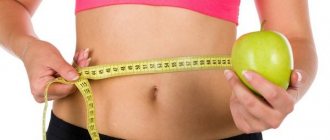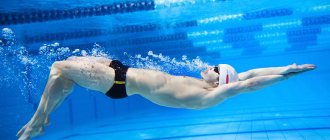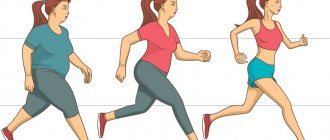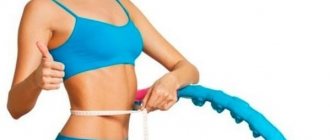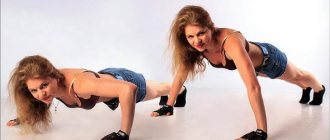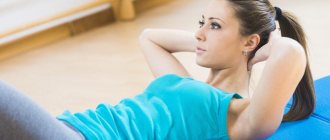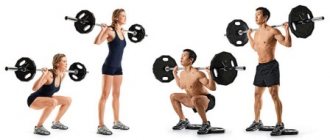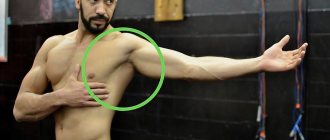You don't have to spend hours in the gym to get your abs in good, toned shape. An ideal alternative is water aerobics for the press, which ideally combines strength and aerobic training.
Ab exercises in water are suitable for girls who want to have a flat, unpumped stomach, as well as those who have problems with the spine and joints.
Let's take a closer look at this technique.
Water aerobics: exercises in the pool
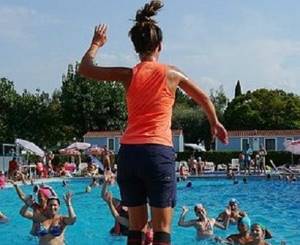
They will allow you to gain harmony and tighten your muscles. Even regular swimming is beneficial.
And if you do certain exercises, the benefits will be doubled.
For those involved in weightlifting, it is especially beneficial to visit the pool.
This will normalize blood circulation and pressure, strengthen the joints and spine.
Water aerobics - effective fitness in water
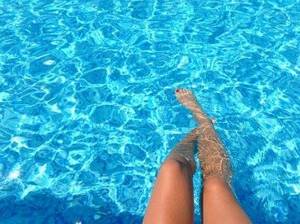
Gymnastics in water is very effective. And that's why:
- in water a person expends more energy and effort than on land, since the load is higher;
- thanks to the pushing force, water softens the load on the joints, and a person can exercise longer without feeling tired;
- water exercises are excellent for training the cardiovascular system;
- the hydrostatic properties of water act as a massage for the whole body and even for internal organs, and this reduces pain during muscle strain;
- blood circulation and oxygen supply to the body improves, the amount of fluid in the body decreases, which leads to slimness.
Exercises in water are available even to pregnant women and people after injuries. And also to very fat people. Swimming makes it easier for them to exercise and helps them lose weight.
Butterfly
This type is the most difficult technically, but the most spectacular and effective for pumping muscles and losing weight. It requires enormous effort and excellent physical preparation. The style allows you to develop high speed of movements. The main muscles that are pumped by butt swimming are located in the area of the upper shoulder girdle. The back also receives a high load, and the legs receive a secondary load.
Here is a complete list of muscles that are trained when swimming butterfly:
- Front, middle and rear beams of shoulders;
- Biceps and triceps of the arms;
- Brachioradialis and palm muscles;
- Dorsal: trapezoid, latissimus, rhomboid, large and small round;
- Press;
- Large pectoralis;
- Quadriceps femoris;
- Calf;
- Musculature of the feet;
- Gluteus maximus.
It is these muscles that are trained by butt swimming, but the level of load that is placed on them is several times higher than, for example, in breaststroke. The style requires high coordination and perfect execution technique. Swimmers work long and hard, honing their movements and increasing their speed. Amateur athletes rarely choose this style of training as their main one.
Complex for different areas of the body: what movements and how to do it
If you confidently stay on the water, then you can simply swim, changing the type of swimming. It is believed that a 40-minute active stay in water is the optimal load for a healthy person. Even those who cannot swim can perform exercises in the pool aimed at pumping certain muscles.
Classes
Technique
Impact
Stand up straight, keep your back straight. Raise your straight leg and the opposite arm at the same time. Lower your leg, raise the other, changing your arm at the same time. Do 20 reps on each leg.
- Legs.
- Press.
Stand up straight, arms extended in front of you. Jump so that your legs are raised together and parallel to the bottom of the pool. At the same time, make a stroke with your hands. Do it 20 times.
Stand up straight and jump so that your legs, bent at the knees, reach your chest. Stay in this position for 10 seconds.
Stand in water up to your chest. When bending your leg at the knee, bend your arm at the same time. And extend the arm opposite to the bent leg forward. Alternate left-right. Do it 20 times.
Stand chest-deep in water, arms in front of you. Raise your knee and at the same time cross your outstretched arms. Lower your knees, spread your arms to the sides. Do it 20 times.
- Hands.
- Press.
Move your left leg back and your left arm too. And pull the right one forward. Throwing your leg out back, move it forward and hit the water with your heel. Do it 20 times.
- Legs.
- Press.
While standing in the water, take one leg back and the other forward. We change and alternate the position of the legs. Do it 20 times.
- Legs.
- Press.
It is advisable to perform all of these exercises in 2-3 approaches, if you have the strength.
Interesting! Active training in water is comparable to running at a speed of 12 km/h. In 40-45 minutes you can burn up to 1000 kcal.
Loads on the abs, and to remove the stomach

Swimming and exercise in water are great for those who want to lose weight, lose belly fat, and have toned abs. A lot of energy is expended in water. Exercises that will pump up your abs faster:
- In a deep pool, take a vertical position. Without touching the bottom with your feet, push off and take a position on your back. Immediately push off and move onto your stomach. Repeat everything again. And so on without stopping 10 times.
- Without touching the bottom with your feet, straighten up. Raise your legs together at a right angle. Lower and raise again. Do 10-20 times.
- In a deep pool, without reaching the bottom, make scissor-like movements with your legs. First in a vertical position, then in a horizontal position. Repeat as long as you have the strength.
You can repeat all three exercises 2-3 times, taking a short break in the form of regular swimming.
For thighs and buttocks
It’s easy to pump up your thighs and buttocks if you do the following exercises:
- Take a standing position in the water and alternately bend your knees, trying to touch your buttocks with your heels. Repeat 10-20 times.
- Take long steps in the water. Try to reach your arms outstretched in front of you with your knees.
- Swim up to the side, lean on your hand, stand sideways. Make swings with the leg that is closer to the side. Then change position and do it on the other leg. 10-15 times.
Any type of swimming is also great for your thighs and buttocks. And also the well-known “scissors” exercise, which can be performed by holding your legs horizontally and vertically.
On the back
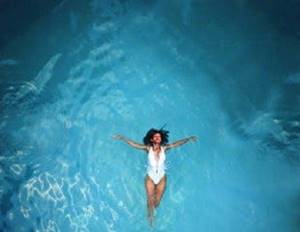
The pool has conditions for doing back exercises. Back and spine training is provided by such activities as:
- Relax on the stretches that separate the swimming lanes in the pool. You need to swim up to her with your back, spread your arms to the sides and grab the stretcher. Throw your head back, arch your back.
- Relaxing on the side. Place your feet and legs on the edge of the pool. The buttocks reach the side, and the head, torso, and shoulders are in the water. In this position, relax and freeze for a few seconds.
- Complete relaxation. You can put your legs on the stretch, and lean on the stretch parallel to it with your arms outstretched to the sides. Completely relax your back muscles.
How to swim correctly to get rid of belly fat
There are certain rules to remove belly fat by swimming. Their implementation will provide the effect of spending time in the water:
- Classes should begin with warming up the muscles. Warm-up before the swim is required (10-15 minutes). Regularity of training (2-3 times a week) and duration (30-40 minutes a day) are important.
- In water, it is important to constantly be in motion - activity in a pool or pond will help you burn off extra calories. Fat reserves are burned when the body takes on physical activity with the heart rate increasing to 130-160 beats per minute. These figures correspond to the level of energy expended per hour - 600-1300 calories.
- You should not use one swimming style throughout the lesson. Different types of exercises involve different muscle groups, there should be at least 3 styles. You need to spend 5-10 minutes on each of them, take a break and repeat from the beginning.
- You need to have breakfast and lunch 1 hour before training. Sports exercises should not be performed on a full stomach.
- After active time in the pool, you should not eat immediately. Eating is possible after 1-1.5 hours, since the body burns calories even after finishing exercise.
In parallel with classes, it is necessary to consume vegetables and fruits. Fiber will cleanse the intestines and body of toxins. You should avoid fatty and salty foods. Healthy eating is the key to the success of your goal.
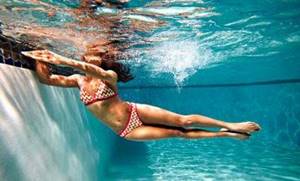
There is a concept called interval training. The entire lesson is divided into certain intervals, including intense loads and periods of rest. This method of losing weight has shown results in pumping up the abs and working out other muscles of the body 10 times higher than other methods. The meaning of interval training is short-term training, but a large expenditure of physical effort. To burn a sufficient amount of energy, 15 minutes of intense exercise in water is enough. They should be carried out as follows:
- for 30 seconds you should swim at full speed, making every effort (it is better to swim butterfly style);
- for the next 15 seconds you need to slow down the pace and switch to breaststroke or freely swim;
- go back to intense swimming, applying all your strength (30 seconds);
- relax for another 15 seconds with slow breaststroke.
At least ten such interval jerks followed by relaxation must be done. Next, the number of intervals is gradually increased with a second-by-second extension of the load time and a decrease in rest. Regular exercise, supplemented by a healthy diet with moderate calories, will not keep you waiting long for results.
Does water fitness help you lose weight?
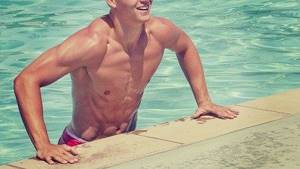
The movements have to be performed with some effort. Especially in sea water. Hence, energy consumption increases. And this is the first condition for losing weight. Aqua exercises allow you to burn from 375 to 606 kcal per hour.
Breaststroke and freestyle swimming allow you to burn up to 1000 kcal per hour.
But in order for swimming to bring quick results in achieving slimness, you need to follow a diet and reduce the caloric content of food.
Attention! Exercising in water acts as cardio exercise. You should pay attention to the speed of your heart beats. The pulse should not be allowed to exceed the permissible norm. And it is calculated using a simple formula: you need to subtract age from 220. This will be the individual permissible value.
Main conclusions
Water aerobics is very beneficial for the body. Its main advantages:
- allows you to quickly gain harmony;
- perfectly pumps all the muscles of the body and internal organs;
- acts as a relaxing and tonic massage;
- accessibility for people with physical disabilities, injuries, and the elderly;
- lifts tone and mood.
To work certain muscles of the body, it is worth studying exercises in the pool and choosing the appropriate load. You need to practice for at least 40 minutes.
What muscles work when swimming?
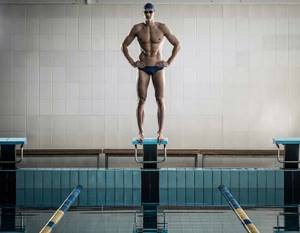
The main working muscles when swimming are the muscles of the shoulder girdle, back and deep muscles of the spine. In fact, these muscles are responsible for creating correct posture, and, among other things, prevent spinal discs from moving and protect against spinal curvature. Due to this factor, swimming is often used in rehabilitative physiotherapy.
Also, when swimming, a significant part of the load falls on the muscles of the core and abs, plus the muscles of the legs and arms (that is, the biceps and triceps). At the same time, the final answer to the question of which muscles work when swimming is what style of swimming you do, how far you can swim in the pool and how good your technique is.
Types of swimming and key working muscles:
- Front crawl - the main load falls on the pectoral muscles (both major and minor), latissimus dorsi (including trapezius), as well as the biceps and triceps brachii muscles. Part of the load falls on the legs (thigh and calf muscles).
- Breaststroke - the main working muscles are the leg muscles (gluteal muscles, thigh muscles, calves), the secondary load falls on the muscles of the arms and shoulder girdle.
- Butterfly - almost all the muscles of the body are involved in the work at the same time. The key load in this type of swimming falls on the latissimus dorsi and leg muscles, but the abs, pectoral muscles and arm muscles are also involved in the movement.
- Backstroke - in this type of swimming, as in front crawl, the load falls primarily on the upper body. The leg muscles are involved only in the pushing movement. However, this type of swimming requires special mobility of the shoulder joint.
Does swimming help you lose weight?
The effectiveness of training in the pool for weight loss has been scientifically proven. Water creates high resistance, which increases muscle tension during standard movements. At the same time, the joints and spine receive minimal stress. This condition ensures the benefits of being in the pool without the risk of injury, regardless of whether the person knows how to swim.
During a measured swim in the pool for an hour, up to 600 kilocalories are burned. With intense exercise, this figure can be increased to 1000 kilocalories. Regular training provides a positive effect after a month of swimming in the pool.
Swimming is not an exercise that affects muscle gain. This sport tones the muscles and gives them endurance. Therefore, it is almost impossible to accidentally build up powerful arms or torso while trying to lose weight.
The popularity of swimming is due to a number of advantages:
- rapid effect of burning fat deposits;
- strengthening the respiratory and cardiovascular systems;
- impact on almost all muscle groups;
- minimal number of contraindications;
- positive effect on flexibility, relief and posture.
To lose weight, it is recommended to exercise in the pool 8 to 12 times a month.
Why is swimming ineffective for those who want to gain weight?
First, let's start with the fact that this is aerobic exercise (like running, cycling, etc.). That is, the muscles do not work at the limit, as is sometimes necessary for their growth, but in a near-limit state. After all, their excessive tension only interferes with the coordination and free movements that a swimmer so needs. And this is not at all enough for muscle growth.
Secondly, only certain muscle groups are involved. Only that which is strained develops, and even then not much. Swimming is a “cyclical” sport that does not even increase working muscles.
The benefits of training in the pool for weight loss
Swimming against excess weight is more effective for women than for men. Exercising in the pool uses more calories than running. Depending on the swimming style, the following is burned per hour of training:
- 500 kilocalories – crawl;
- 520 kilocalories – breaststroke;
- 560 kilocalories - on the back;
- 570 kilocalories – butterfly.
In addition to destroying fat deposits, swimming:
- prevents the development of flat feet;
- stimulates lung function;
- supports the physical fitness of pregnant women;
- has a massage effect.
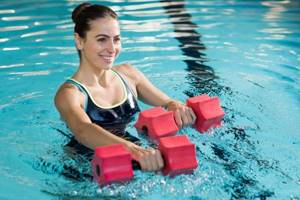
To burn excess weight, the water temperature in the pool should be from +24 to +28 degrees Celsius. During training, you need to alternate styles. Before swimming, you should warm up: before immersion in water, and after. At the initial stage, the training duration should be 30 minutes. In the future, the lesson time increases to 1 hour.
For weight loss, intensive swimming is recommended at the beginning of the workout, slow and relaxing at the end. After class, you should not eat food for an hour and a half to consolidate the effect.
You can get the maximum effect from training in the pool by combining swimming and water aerobics.
Back crawl
Now let's list which muscles work during water style swimming. It is the most favorite among professional swimmers because it allows you to develop very high speeds. The style requires excellent physical shape, developed breathing and high endurance, since it is considered very energy-intensive. The main load in the front crawl is on the arms and shoulders, while the legs act as stabilizers in space.
So, check out the list of muscles that develop when swimming front crawl:
- Deltoid shoulders (anterior, middle, posterior bundles, as well as rotator cuffs);
- Dorsal: latissimus, trapezoid, large and small round, diamond-shaped;
- Triceps and biceps brachii;
- Brachioradial;
- Sternocleidomastoid;
- Anterior serratus;
- Oblique and straight abdomen;
- Gluteus maximus;
- Quadriceps and hamstrings;
- Calf;
- Anterior tibial and adductor magnus;
- The muscles of the palms and feet also work.
These are the muscle groups that are affected by water-style swimming on the chest in the pool; as you can see, the list is no less impressive. However, here the technique requires a higher tempo, so more energy is spent during the crawl. In other words, the muscles work harder.
Let's continue our review and move on to the next style. What muscle groups are affected by backstroke swimming in a pool? It is no secret that this type is considered the least energy-consuming. To increase the load, we recommend swimming quickly and without rest breaks. The work involves, first of all, the arms, then the legs.
Check out the list of muscles used when swimming the back crawl in the pool:
- Deltoids;
- Musculature of the forearm;
- Biceps and triceps of the arms;
- Muscles of the palms;
- Latissimus, major and minor round, diamond-shaped and trapezoidal backs;
- The core and abs muscles work as stabilizers;
- Large pectoralis;
- Sternocleidomastoid;
- Quadriceps and hamstrings;
- Calf;
- Gluteus maximus.
This style of swimming strengthens the muscles of the arms and core, while using the legs to a lesser extent. Its technique is similar to the front crawl, but here the athlete does not need to practice breathing techniques with his face immersed in the water.
Well, we have analyzed 3 swimming styles available to any beginner. We hope that the question “is it possible to build muscles by swimming in a pool” is no longer in front of you. Next, we move on to the most complex and most energy-consuming style, which is extremely difficult to master on your own.
The best sets of exercises
Basic
The basic complex for weight loss consists of swimming and water gymnastics. Weight loss training is different for women and men. For females the following complex is provided:
- crawl swimming for 10 minutes - warm-up stage;
- swimming without the help of legs for 5 minutes - load on the arms, shoulders, pectoral muscles;
- alternating breaststroke and crawl for 10 minutes - the main stage;
- swimming with a board for 10 minutes – load on the legs;
- swimming for 10 minutes with increasing speed is the main stage;
- Slow swimming for 15 minutes in any style is the final stage for relaxation.
After swimming, it is recommended to do water gymnastics, or perform steps underwater.
Training for men is carried out according to the following scheme:
- warm-up – 5 minutes;
- swimming in any style with increasing speed – 5 minutes;
- swimming with a board using only legs – 10 minutes;
- backstroke – 10 minutes;
- swimming with alternating fast and slow tempos – 15 minutes;
- slow relaxing swimming in any style – 15 minutes.
The list of basic water gymnastics exercises includes:
- jumping in water;
- shocks from the side of the pool;
- running in the water.
Water aerobics is usually performed under the supervision of a trainer. Doing the exercises on your own is not recommended even for experienced swimmers.
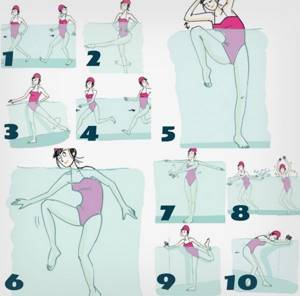
For belly slimming
To remove fat deposits on the abdomen and sides, a comprehensive program has been developed, including:
- aquafitness;
- water aerobics;
- exercises for the abs;
- exercises for the waist.
Aquafitness additionally makes the skin more elastic. This feature minimizes the risk of stretch marks appearing after burning excess weight. Aquafitness includes the following exercises:
- jogging underwater while in the pool waist-deep or higher;
- pushing and pulling the swimming board with your hands while in the chest-deep pool;
- swimming on your back using your legs.
Water aerobics provides the effect of strength training. It is recommended in addition to aquafitness, or for people who do not feel the strain from it. Water aerobics consists of a set of exercises:
- jumping in neck-deep water with straight arms - you must try to touch your toes to your palms;
- jumping in chest-deep water with legs spread wide - at the moment of the jump, the legs are brought together, and when diving, they are placed as wide as possible;
- lifting the legs to the chest in the position of a hedgehog on the back in the water.
What you will need for classes
Before going to the pool, you need to stock up on special paraphernalia. If you just plan to tighten your figure and reduce your waist, a comfortable swimming suit is quite enough. For recovery procedures, athletes will need additional tools:
- aqua-cantels;
- gymnastic sticks;
- exercise machines for working out muscle mass;
- boards and cuffs.
Experts believe that you should always have an aerobics belt with you. It will help to evenly distribute the load on the abdominal cavity and sides.
Water aerobics
Water aerobics includes two stages: warm-up and main. The first stage consists of simple exercises:
- inhale and exhale while raising your arms up while standing in the water;
- mill using hands with movements in different directions (hands are completely in the water);
- tilts in different directions - the neck should not fall below the water level;
- jumping out of water;
- bending the legs at the knee with lifting to the buttocks.
The warm-up stage is mandatory before moving on to the main stage. The second stage includes physically difficult exercises, during which you can get injured if you skip the warm-up. Basic exercises include:
- swing your legs up while sitting with your buttocks at the bottom of a pool with water level up to your chest;
- jumping in water from a squat (performed at a minimum depth);
- scissor kicks in chest-deep water;
- rotation of the waist in the water, holding on to the side.
During rest periods between exercises, you should walk in water. Standing still can cause you to freeze. Water aerobics burns body fat when done three times a week.
You can learn how to properly perform exercises in the pool for weight loss by reading the instructions in this video:
Training in the pool is an effective method of combating excess weight. Water classes include a set of exercises aimed at working the entire body. But to obtain the maximum effect with minimal risk to health, training in the pool must be performed strictly in accordance with the instructions, and under the supervision of a trainer.
Breaststroke
Breaststroke is a style in which all movements of the arms and legs are performed in a horizontal plane. This is the slowest type, but the most comfortable for long-distance swimming. The main engine that is mainly involved in propelling a swimmer forward is the legs. The hands work second, then the body.
Check out the muscles that move when swimming breaststroke in the pool:
- Quadriceps and hamstrings;
- Gluteus major, minor and medius;
- Calf;
- Hip adductors;
- Iliopsoas;
- Transverse and oblique abdomen;
- Latissimus dorsalis;
- Trapezoidal, large and small round, diamond-shaped;
- Deltoid muscles of the shoulders;
- Biceps, triceps, palm muscles;
- Brachioradial;
- Large pectoralis;
- Musculature of the foot.
We have listed which muscle groups work when swimming breaststroke; as you can see, almost the whole body is involved in the process. This is where the complexity of the impact of water sports on the human body is expressed.
Benefits of fitness in water
Water aerobics classes help relax the body, they relieve irritability and overexcitement. Active water treatments improve your mood and help you cope with stressful situations. This is especially important for those who are struggling with excess weight and are forced to limit themselves in food and positive emotions.
Due to the loss of physical tone, people begin to feel embarrassed about their body. By performing simple exercises in water, you can successfully combat sagging skin, the appearance of cellulite and excess weight. Water hides figure imperfections from prying eyes, so many people can exercise without discomfort.
You can not only overcome your fear, but also learn how to float on the water and improve your figure.
Fitness in the pool is ideal for older and overweight people, expectant mothers, while exercise in the gym may be contraindicated. Water minimizes stress on the joints, so the likelihood of injury is very low. But the muscles exert more effort due to the fact that they are forced to overcome the resistance of the water. Regular exercise will change your body beyond recognition! After one workout in water, a person can lose up to 800 kcal!
The most effective exercises in water
Exercises in water - swings
This exercise is especially effective for the back of the thighs.
Standing in water up to your neck, stretch your arms in front of you and lift your leg, while trying to reach your toes with your toe. Perform each exercise 10 times for each leg.
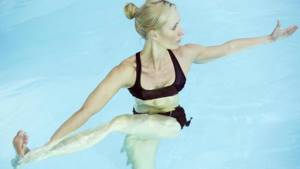
Experts also note that this exercise in water can be diversified by performing swings not only forward, but also in different directions. At the same time, change the intensity, this will also allow you to use the muscles of the inner thigh.
Exercises in water - ballerina posture
To achieve a ballerina-like posture by the end of your vacation, when standing in the water, always straighten your back and draw in your stomach.
For greater efficiency, you can also slightly tilt your body forward and backward. This will improve your posture even faster.

Exercises in water - exercise for arms
If you have weak arms, this exercise in water will help you. Walk into the water up to your neck, place your feet shoulder-width apart, and bend your knees slightly.
Underwater, spread your arms slightly to the sides and begin to rake and rake the water with your palms.
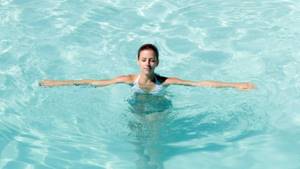
Perform this exercise 10 times in 3 sets. This will give you a great workout for the muscles of your arms, chest and back.
Exercises in water - steps on water
Walking on water will help tighten the muscles of the back of the thighs and buttocks. In this case, you need to raise your knees high and stretch your arms in front of you. A
if you spread your arms to the sides, the muscles of the back, chest and arms will join the process.
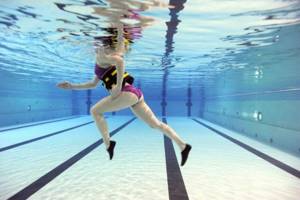
Just 20 minutes a day of this kind of walking, and in a week your butt will become elastic and toned!
Exercises in water - overwhelm
The body is in an upright position. Alternately bend your right and left legs at the knee joint. The back is straight, the pelvis is forward, the buttocks are tense. Then bring your knees together (look at the bottom). Try to touch your heel to your buttock. Breathing is voluntary.
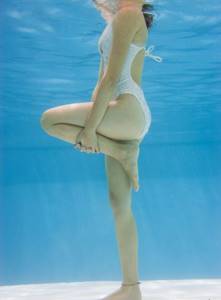
Option in a sitting position. Stretch your legs forward (at right angles to your body), holding yourself on the water with your hands.
Exercises in water - abdominal exercise
Lying on your back, arms to the sides, palms down. As you exhale, pull your knees towards your chest. As you inhale, return to the starting position. Alternately pull your knees towards your right and then your left shoulder.
An option for those who cannot swim. Pull your knees to your chest, pushing out of the water with your palms. The abs are tense, the back is straight. Don't strain your feet, keep your toes on the water.
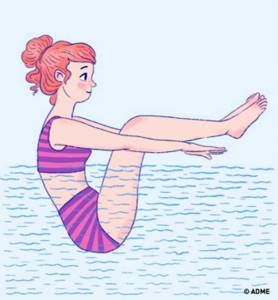
Exercises in water - massage
This exercise will help you get rid of cellulite, as the water pressure creates an excellent lymphatic drainage effect.
Place your hands together and, with force, move them sharply along the surface of your thighs and waist at least 10 times.
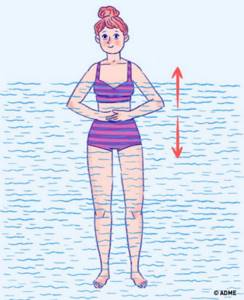
To enhance the anti-cellulite effect, it is better to give up junk food.
Exercises in water - leg abduction and extension
Place your feet together, arms at your sides, palms down. Spreading your straight legs, lower your straight arms down.
Then bring your legs together and raise your arms with your palms facing up. Keep your back straight. Return to the starting position.

This exercise in water can be performed with small or large amplitude.
Exercises in water - spinning and spinning
The following exercise in water will help you reduce your waist by at least two centimeters.
Stay on the water by rowing with your hands, while at the same time pulling your knees towards your stomach, turning them in different directions 90 degrees. Perform 10 repetitions in each direction.
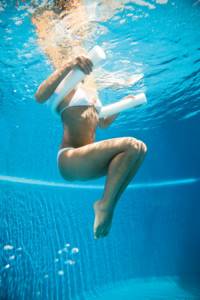
And in order to better work the oblique abdominal muscles, it is necessary to change the amplitude and speed of movements.
Exercises in water – underwater games
A great way to lose weight and pump up all your muscles is to play on the water. For example, playing volleyball in a month will help you lose one size.
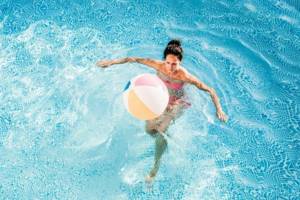
One has only to look at the water polo players - perfect figures and not a bit of excess weight. So playing with a ball is an ideal way to get rid of extra pounds.
How do you feel about exercise in water? Maybe you have some of your own ideas or interesting proposals?
Sources:
https://gercules.fit/pohudenie/uprazhneniia/akvaaerobika-uprazhneniya-v-bassejne.html https://diets-10.ru/uprazhneniya-v-bassejne-dlya-pohudeniya.html https://stroiniashka.ru/ publ/22-1-0-1237
How to tone your abs by swimming
Sculpt your abs, tone your abdominal muscles, and strengthen your body using our tips on how to use swimming to do this.
Swimming on its own is already a great workout for all muscles, but with a few exercises during your workout you can further strengthen your abs.
Breaststroke, butterfly and backstroke are some of the most suitable strokes for strengthening all muscles, but we would advise alternating styles during training.
Swim to strengthen and tone your abdominal muscles, following the tips and tricks of outstanding swimmers.
Water resistance training
While in the water, stand with your back straight, look ahead and start running or walking - due to the additional resistance of the water, you will have to put in much more effort than normal walking. Raise your knees as high as you can and you will feel your abdominal muscles begin to work. Training Gear Tip: The Speedo aqua belt is a great tool for this type of training as it keeps you upright.
Footwork
If you want to switch things up, you can do a little leg work in the deep part of the pool to add some variety to your workout. For maximum effect, raise your knees as high as you can and maintain tension in your abdominal muscles. Try doing this for a minute without stopping.
Swimboard exercises
Introducing a swimboard into your training process will help maintain abdominal tone. When you lie on your back and hold the paddleboard on your chest, your abdominal muscles do a lot of work to keep your body afloat and your head above the water.
"Capture the Wall"
To take your abdominal tone to the next level, try an exercise we call the wall grab.
While near the wall of the pool, lean your elbows on it, then begin to raise and lower your legs (straight or bent - at your discretion). Do the exercise for 10 seconds, then rest. Repeat as much as you want or can!
Want to lose maximum calories in the pool? Read our recommendations on How to burn calories in the pool without lengthening your sessions.
Source

